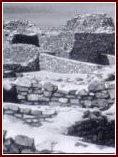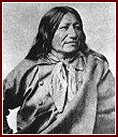 Arts Arts
 Educational technology Educational technology
 Foreign languages Foreign languages
 Health and safety Health and safety
 Language arts Language arts
 Mathematics Mathematics
 Physical education Physical education
 Science Science
 Social studies Social studies
 Vocational education Vocational education
 Indian Heritage Month Indian Heritage Month
 Women's History Month Women's History Month
 More... More...

FirstGov.gov

|
 |
| |
Edward S. Curtis's The North American Indian: Photographic Images is one of the most significant and controversial representations of American Indian culture ever produced. Issued in a limited edition from 1907-1930, the publication continues to influence the image of Indians in popular culture. In over 2000 photos and narrative, Curtis portrayed customs and lifeways of 80 Indian tribes. (Library of Congress)
Interesting fact: Two Strike, chief of the Brulés, was born 1821. At the age of 12 he accompanied his first war party. He fought in 22 battles and was never wounded. He never fasted to see a vision. He wore a bear's ear "to frighten the enemy." Read more. |
|

Two Strike |
|
| |
 |
| |
Campfire Stories with George Catlin: An Encounter of Two Cultures takes students on a virtual journey with the artist and ethnologist to meet Native Americans of the 1830s. His portraits, scenes of American Indian life, and writings depict cultures prior to U.S. expansion into tribal territories. (Smithsonian Institution)
Interesting fact: Agreements between the U.S. government and Native Americans were reflected not only in written treaties but in wampum belts. The belts, created and used largely by the Iroquois Nations, represented the values and sentiments surrounding an agreement or event. Read more. |
|

Horse Chief |
|
| |
 |
| |
Tracking the Buffalo: Stories from a Buffalo Hide Painting puts students in the role of historians as they examine a buffalo hide painting and click on areas that reveal clues to the painting's story. The story helps students understand the role of the buffalo in the lives of the American Indians of the northern plains. (National Museum of American History, supported by Smithsonian Institution)
Interesting fact: Indians of the northern plains wore buffalo hides for both practical and ceremonial purposes. They wore buffalo hides in winter, with the fur on the inside for warmth. Read more. |
|

Buffalo hide painting |
|
| |
 |
| |
National American Indian Heritage Month features dozens of historic sites, lesson plans, and travel itineraries for learning about Native American history. Find out about Haida totem poles, village life in Hidatsa and Mandan tribes on the plains, sacred ceremonial sites for the Yoeme (Yaqui) people, daily life of the Pueblo Indians, mounds of Mississippi and the Ohio River Valley, and more. (National Park Service)
Interesting fact: Although the first people entered what is now Mississippi about 12,000 years ago, the earliest major phase of earthen mound construction in this area did not begin until some 2100 years ago. Mounds continued to be built sporadically for another 1800 years. Read more. |
|

From the village of Shishmaref |
|
| |
 |
| |
The People ... Native Americans offers more than 30 collections of photos, essays, and other resources for learning about American Indians. Topics include daily life for Native American women, the Wounded Knee Massacre, Custer's Last Stand, and Pocahontas. Resources include a tribe locator, recordings of Native American music, and an exhibit of flutes. (Library of Congress)
Interesting fact: Pocahontas was the daughter of Powhatan, an important chief of the Algonquian Indians (the Powhatans) who lived in the Virginia region. Her real name was "Matoaka." Read more. |
|

Tribes & cultures |
|
| |
 |
| |
The Trail of Tears: The Forced Relocation of the Cherokee Nation tells about the removal of the Cherokee Nation from their ancestral homeland (NC, TN, GA, AL) to "Indian Territory" (now Oklahoma). After passage of the Indian Removal Act and the discovery of gold on Cherokee lands (1830), about 100,000 American Indians living between the original 13 states and the Mississippi River were relocated to Oklahoma. The trails they followed came to be known as the Trail of Tears. (National Park Service, Teaching with Historic Places, National Register of Historic Places)
Interesting fact: Between the 1830 Indian Removal Act and 1850, the U.S. government used forced treaties and/or U.S. Army action to move about 100,000 American Indians living east of the Mississippi River, westward to Indian Territory in what is now Oklahoma. Read more. |
|

Southeastern tribes, 1820s |
|
| |
 |
| |
American Indians of the Pacific Northwest features more than 2,300 photographs and 7,700 pages of text relating to the American Indians in two cultural areas of the Pacific Northwest: the Northwest Coast and Plateau. These resources illustrate many aspects of life and work, including housing, clothing, crafts, transportation, education, and employment. (Library of Congress)
Interesting fact: Of all the Native Americans who lived or are living in the Pacific Northwest, two who enjoy the most recognition are Chief Seattle and Chief Joseph. Seattle was the Lushootseed leader after whom the city of Seattle was named, the largest city to be so honored. Read more. |
|

Spokane encampment |
|
| |
 |
| |
Gran Quivira: A Blending of Cultures in a Pueblo Indian Village can help students understand daily life and how it changed for the Pueblo Indians of Gran Quivira, the largest of the three Salinas pueblos located in central New Mexico. (National Park Service, Teaching with Historic Places, National Register of Historic Places)
Interesting fact: In the remote Salinas basin in central New Mexico stand the weathered ruins of three Puebloan villages and the 17th-century Spanish colonial missions that make up Salinas Pueblo Missions National Monument. Two ancient southwestern cultural traditions—the Mogollon (muggy-own) and Anasazi—overlapped here and resulted in the Puebloan communities of Abó, Quarai, and Gran Quivira (also known as Las Humanas). Read more. |
|

Gran Quivira Unit |
|
| |
 |
| |
The Sioux Treaty of 1868 examines Native American sovereignty and the Constitutional power granted to the president and the Senate to make treaties with foreign nations. The site presents the Treaty and related documents, including a photograph of the Indian leader, Spotted Tail. Explanatory text, materials for teachers, and links to further resources accompany the documents. (National Archives and Records Administration)
Interesting fact: The Black Hills of Dakota are sacred to the Sioux Indians. In the 1868 treaty, signed at Fort Laramie and other military posts in Sioux country, the United States recognized the Black Hills as part of the Great Sioux Reservation, set aside for exclusive use by the Sioux people. Read more. |
|

Spotted Tail |
|
| |
 |
| |
The Battle of Horseshoe Bend: Collisions of Cultures looks at the decisive battle of the Creek War (1813-1814), where Andrew Jackson fought 1,000 American Indian warriors who were trying to regain autonomy. It examines the history of the battle and provides maps, images, and readings. (National Park Service, Teaching with Historic Places, National Register of Historic Places)
Interesting fact: It was around 1680 that English traders started talking and writing about the "Creek" Indians. They first applied this name to the people who lived near Ochesee Creek in northern Georgia, where there was active trading of European manufactured goods for deerskins. Read more. |
|

Horseshoe Bend |
|
| |
 New Resources New Resources
|

![]() New Resources
New Resources ![]() Searches & Subjects
Searches & Subjects ![]() More For Students
More For Students ![]() What is FREE?
What is FREE? ![]() Comments & Feedback
Comments & Feedback![]()
![]()
